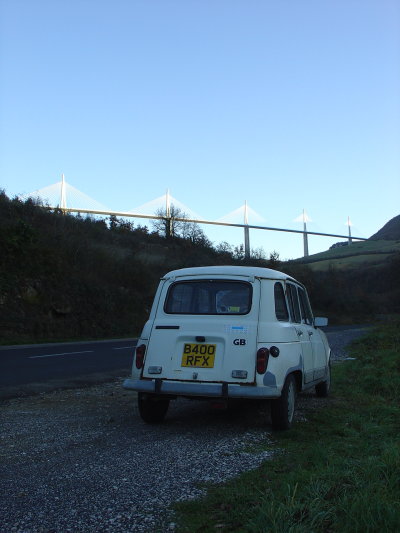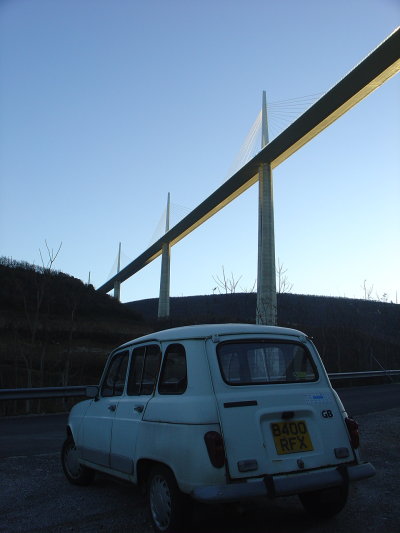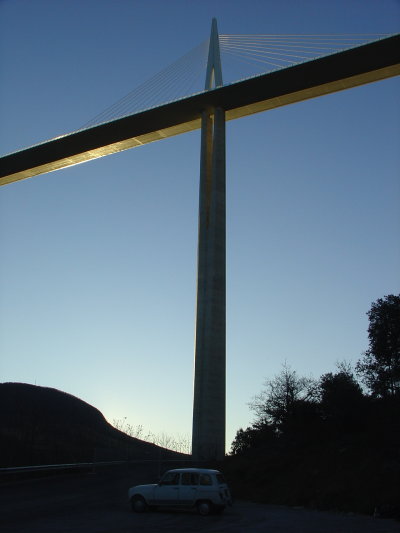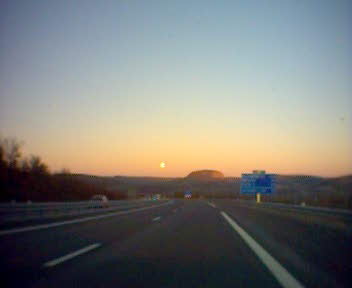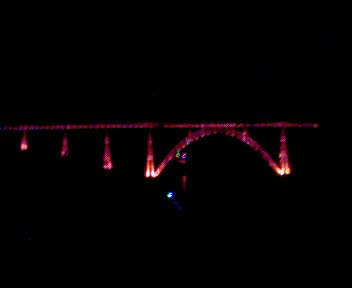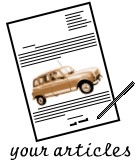
Rouen, Reflexia and the Open Road
page 5 of 5
by Peter Gumbrell, 22 December 2008
continued from part 4 - click here to go to the start of the article
One of the few redeeming features of my hotel in the city of Montpellier (or rather, in a place that could have been the dog end of any city in the world but which in this case was vaguely in the vicinity of Montpellier's industrial backwaters) was the free wi-fi. It was Friday morning, and my original ferry booking from Dieppe was scheduled for the Saturday night eight days hence. The trip was costing me a lot in fuel, lodging and other expenses, and it wasn't affording me the best opportunity to check out all these potential new home cities in the beginnings of a frozen, barren wintertime. I had been considering going north-east to Lyon, but my original desire for my future study explorations was to visit Marseille and Nice, in addition to the other locations, and taking those in would be another lengthy detour in consideration of my ultimate need to reach the northern French coast.
I discovered that the ferry operator had revised their sailing times for the approaching weekend, now proposing some more feasible crossings at less ridiculous hours, so I suddenly turned my thoughts towards a straight route back up the middle of France, despite the demands of more intensive driving this would bring about. Though I'd done the north-south route in a day, I certainly didn't feel like trying to match that achievement in reverse, so my goal was now to get to somewhere in the middle of France by nightfall. To reach that target, I would take a route that would lead me via one of the engineering marvels of the modern world.
With another near-starvation experience involving the fuel solved by a last-ditch refill west of Montpellier, I continued to the A75, one of few largely toll-free motorways of any reasonable length still remaining in France. There was just one toll waiting ahead, but one that I was prepared to stump up a quite considerable sum of money for if necessary, armed with the knowledge of its purpose. I had my camera at the ready to film my Renault 4 as it neared one of the grandest pieces of architecture and construction ever envisaged. The road began climbing ever more steeply, as my car again crawled in the lorry lanes around dramatic gorges, finally emerging at high altitudes on the top plains above. I was heading into the Aveyron département, from whereon I would be entering once again the Auvergne region, a part of France that my Reflexia had discovered three years earlier, and my favourite part of the country.
Despite the cold air and the snow visible on distant mountain tops, I was driving under a clear blue sky, and the sun was beating down into the rear of my car with just enough warmth to make up for the lack of such available from my troublesome heater. Several split-second glances at the map on my passenger seat showed that I was now only a couple of bends off of my holy grail. With camera in one hand and steering wheel in the other, I was calmed by the lack of much other traffic around - especially on my side of the carriageway - from cluttering the view in front or forcing me to lower the lens in suspicion of law enforcement patrols. I slowed to allow a couple of speed freaks to zoom well ahead, and closed on the final bend with a clear view ahead of the glorious spectacle I had been waiting for, the Viaduc de Millau.
What with my divided loyalties to both driving and filming, it was rather difficult to engage in a third activity of savouring the moment as I crossed the 2.5 kilometre-long bridge. Not a single other vehicle spoilt the view either in front or behind. I had the whole thing to myself! This particular route down the centre of France was considerably more busy in the holiday season, when all the north of France takes to their automobiles to infiltrate the southern half, leaving their grannies behind to bake in the summer oven, and leaving bewildered tourists wondering why every voice they hear around Paris is anything but French.
The crosswinds battering my car during the morning's drive had been a cause for concern, but thankfully the shields on the bridge were so effective that my crossing was the least blowy part of the entire day's journey. Soaring through a high sky past the seventh and last pylon, I squeaked across the join of the final span back onto solid ground, then veered off into the service area, which offers a panoramic viewpoint of the viaduct and its breathtaking setting in the Tarn valley. Satisfying myself with some extended gawping, a pair of chilled pink ears, a perusal of the souvenir shop, a coffee and a screening of a short film that seemed to over-glorify Jacques Chirac's involvement in the realisation of the project, a good two hours had been killed and I should have continued my northbound charge. Admiring the scene from the top alone wasn't enough for me, however, so I detoured down into the valley, through the busy town of Millau and out onto a small road running beside the River Tarn that I'd observed from above.
It was certainly a worthwhile diversion, and I hit the almost empty road west as the sun lowered itself in the afternoon sky, lighting up one half of the viaduct and also the pretty village of Peyre below. A turn-off at the foot of one of the immense piers takes drivers over the river and up a steep climb to a visitor information centre, but an offshoot used during the construction of the bridge provides a stopping point, which on this quiet winter weekday was devoid of any other public intruders and, remarkably, of any sound from vehicles passing on the roadway high above. The wind shields along the carriageway also provide good noise insulation, and the only audible environmental events were the peaceful flowing of water down the river nearby, and the pre-dusk tweets of birds staying put for the cold season. You couldn't blame them for not giving up their lodges in such a serene setting.
The two closest piers to this deepest point in the valley rise unfeasibly to support the motorway one quarter of a kilometre above, with one mast reaching a record-breaking 343 metres at its peak, higher than the Eiffel Tower. It's difficult to stand at this spot and appreciate that thundering lorries and a multitude of other vehicles are hurtling along in the sky on a four-lane highway (an apt word).
A certain reluctance to leave these enchanted surroundings was only losing the battle against my coldness. I'd whittled away the afternoon loitering around this one point on the map, and my original intent of reaching the middle of France was now competing with the notion of staying put in a local hotel, in order that I could return to see the viaduct illuminated by night. After all, it might be a long time before I should ever revisit the area so why not make the most of the opportunity? In a similar mode of thinking that has prevented me rounding off other adventures, like climbing only halfway up the Eiffel Tower and shunning its upper section, or forgoing the opportunity to jump on a passing tram car in San Francisco, I decided to leave Millau and imagine a future occasion will materialise when I could still have something new to savour there.
Once I had wound my way back to the summit north of the town, it seemed that my simple strategy from here was to just drive and see how far I got. The dark of night was about to hunt me down and I had nothing more to expect out of today than a dinner and a bed. But shortly after rejoining the autoroute, and moments after the sun had hidden beneath the rear horizon, I turned a bend and was confronted with a beauty of nature's making that rivalled the magnificent experience of the man-made bridge I'd left behind. As if to compete and prove that, ultimately, nothing can outdo the phenomena of the world's own creation, a giant full moon bigger and brighter than any I'd seen before had risen above rocks resembling the Grand Canyon, against a back light of a supernatural purple and pink sky.
Hurriedly, I attempted to capture a shot in motion as I drove, only to find my camera had exhausted its battery supplies after all my snapping back at the bridge. The single shot I managed to obtain (below) didn't represent the colours correctly or the drama of the scene being acted on the sky's stage, and the zoom would not function before the device retired like a shy child in a school play and refused to make another stand.
For the ensuing twenty minutes, I chased the moon ahead and the view became only more sensational, with vivid hues of orange, green, yellow and blue lighting up the southern skies behind me and in my mirrors, complementing the increasingly luminous picture in front. I had to concede that whatever I had witnessed that afternoon had been eclipsed by this moment. I wished that the whole world could have been in the back of my R4 to see the same sight as myself.
My mobile phone camera was also dug out in my furious attempts to save the scene for posterity, but that too would utterly fail at the job of recomposing reality.
The motorway climbs steadily as it progresses further north, and location markers positioned every kilometre display the current altitude. As the road plunges up and down often steep gradients, this facilitates an ad hoc adaptation of Play Your Cards Right, in which I must guess higher or lower on approach to each sign. At 860 metres, I thought it unlikely that I'd be wrong to keep guessing lower. However, the surroundings turned to a white of a mystical quality, as the intensely bright moon shone against the snowy ground surfaces set against a backdrop of dark, silhouetted distant mountain ranges. The temperature inside my car had now dropped to an unfunny low. I was having to keep one hand held inside my coat whilst the other was on the wheel, swapping them every few minutes. The altitude peaked at an exhilarating 1,221 metres, and twice more reached within a short stroke of this record, and I was glad for every metre dropped beyond that, for my limbs were now numb.
Regular signs had been appearing giving distances to not just the bigger towns and the ultimate destination of Clermont-Ferrand to which this motorway led, but also to the Viaduc de Garabit, a superb rail bridge designed by Gustave Eiffel that I'd visited with Reflexia in 2005 (see article YA19 in this section). Constructed in 1884, it was as striking in its time as the Millau Viaduct is today. Indeed, it is still an impressive feature in the region, but not one I had expected to see continually referenced on the road signs from more than one hundred kilometres away. After all, it is just a rail bridge spanning a splendid rural setting, there's nothing much else there for highway cruisers to need be distracted by. When I eventually reached the final sign pronouncing the imminent arrival of the viaduct, I hadn't expected to see anything of it by night, but then the reason for its inclusion in countless previous information signs seemed no longer to be in dispute, as a marvellous golden orange light appeared to the left of my vision, and the illuminated girder work of its construction unfolded in dazzling style.
I pulled off at the adjacent aire, discovering only a deserted car park with a toilet as the sole feature of the stopping point, and continued refusals from my camera to operate until I catered to its energy hunger. Now, the puny photographic device on my ancient mobile phone was going to provide the only means for recording another monument and moment from possibly the greatest day's drive in my life.
By night, the Garabit Viaduct provided a landmark for every driver to be guided by, and for every child in a family car to persist in asking how far until they reached it. I was now most interested in how far until I reached somewhere that provided warmth, and should my car somehow fail me at this point I would surely be in trouble, since my fingers were now barely able to dial a number on my phone. Some forty-five kilometres further on at Lorlanges, I steered off the autoroute into a service area, and whilst the petrol station was seeing a steady stream of cars passing through, the road uphill to the restaurant, hotel and other services had barely been tyre-trodden, and was covered in thick cracked ice. Uncertain if the facility was open, but miffed should it be closed at 7.30pm on a Friday evening, I hesitantly stepped down to first gear and offered the slippery slopes to Reflexia. She didn't complain and I arrived in a completely empty car park that didn't hold out much promise. Unless the staff were expert cross-country skiers I couldn't see how they would have got in there.
Inside the doors, however, was a perfectly normal, functioning service area, albeit without any people. I selected from the extensive buffet full of cooked food that would likely find no home for the night, and waited whilst the sole member of staff completed her multi-tasking role that kept the whole place alive. For the duration of my meal, not a single soul walked through the door. I wondered if I went back the following day, whether the place would still exist, or it would prove to have been a figment of my imagination. The cold can do strange things to one's mind.
I pondered over the possibility of resting in the neighbouring hotel for the night, though I was a bit concerned that if the weather worsened I could find myself and my car stranded by the morning. The weather forecast showed this region as being the coldest in all of France, sinking to -7 Celsius overnight. The rates were also a little over my usual budget, so I took to the car for one last surge north. Sticking loyally to the FastHotel chain that I'd depended on twice already, I referred to their location guide, and ploughed on to Clermont-Ferrand, where I checked in for the night. It was another motel like the one in Montpellier, near an industrial estate near the airport and about as far from glamorous as it was from Las Vegas, but it was basic, warm and would serve my needs for the next twelve hours.
The extreme cold was all too evident the next morning, when I opened the door of my motel room for one second and forced the heater to spend the next few minutes automatically raising the temperature back to a stable level. By the time I had faffed about with the free wi-fi a little longer, the morning was not far from over. I rang up the ferry company, Transmanche, and took a gamble by booking myself onto the eight o'clock sailing that evening from Dieppe, one full week ahead of my original schedule. To reach La Manche by the latest advised check-in time of 7pm, I would face a stern test of my driving abilities against the clock. By now, I'd come to expect nothing more having zipped about France and Spain in such a mad flash.
At just past eleven o'clock, I set out on what I hoped would be the last long slog on the road, but after an hour avoiding the toll roads, I hadn't even reached the town of Montluçon, which I had estimated was where I would need to be by that time if I were to not miss the boat. All manner of petrol tankers, farm vehicles and old dodders were obstructing my path on single carriageway roads, and finding a suitable passing point was further hampered by my right-hand driving position. Then the skies clouded over and the road surface became more damp and dangerous. It was clear that at some point I would have to pay up for the tolls and break with my self-imposed restriction on their use. One good straight stretch south of Bourges was sabotaged by a twin oil tanker combo that I just couldn't get past, as the surface spray saturated my screen and conditions became hazardous. I switched allegiances to the toll road between Bourges and Orléans, and made up for lost time.
From Chartres via Dreux to Évreux, I retraced the route I'd taken southwards when I first left Rouen twelve days earlier. The crossover from day to night was less pronounced, since the ugly, gloomy wet weather only served up darkening shades of grey, and yet again I was running desperately short of fuel having not passed a garage or service area for dozens of miles. This time, the needle was not even wavering, it was just stuck firm left, and with rain belting down in the dark, and my ferry leaving in just a couple of hours, I found myself leaning forward at the blurred windscreen with tensed muscles and intense concentration, seeking any scent of a roadside light that might signify a garage. My motor must have been feeding on just the last drop in the feeder pipe when I found one, but the challenge was not over yet.
As I re-entered Rouen, I cursed and shouted in a deranged state when the motorway split and none of the road signs indicated which route led to Dieppe. In such treacherous conditions and with only a printed atlas in a dark car, I could only hazard a guess, which fortunately turned out to be a good one. But having already done the Rouen - Dieppe journey three times in recent weeks, I knew that I needed close on an hour to make it. The time was already half past six, and I'd read previously on the Transmanche website that the absolute minimum check-in time was forty-five minutes, which was exactly what now remained for me to get there within limits.
My foot had been firm to the floor most of the day, indeed for virtually the whole trip, and I sometimes needed to put pressure on the muscle above my knee using my hand, in order to relax it from the constant strain it was being put under. Once again, the unending rain and spray was leaking through to the driver's footwell and saturating my trouser legs and shoes. This one was going to go right to the wire! As my car struggled on the uphill slopes leaving Rouen, I willed it on to find some secret supergear. On the motorway towards the coast, I was struggling to see any road markings and had my face almost pressed to the glass again. If I thought I was pushing things to the limit, I wasn't the only one. A van towing a trailer came hurtling past in the outside lane, dicing with death from what I could see, and then I spotted the UK number plate. As we neared Dieppe, other UK-registered cars were swerving around soaking roundabouts. The drive had turned into some psychopathic race from a fantasy computer game as we all tried to get one up on the competition. Upon penetrating the outer fringes of Dieppe, a limitless series of road signs and roundabouts must be navigated, each time the advertised distance to the car ferry terminal seemingly not reducing. I overtook the trailer van on a hill, and although almost nothing else was visible, I could clearly see the grimace on the driver's face as he realised he just might not make it. I couldn't believe that Reflexia had held up and not skidded at any time, especially with the full tank of fuel and most of the luggage weight sitting on the rear axle.
With the next ferry not leaving till a day later, nobody wanted to spend a wet December evening and lifeless cold, grey Sunday in a dodgy Dieppe bed and breakfast. Finally, after an eight-hour sprint from the centre of France, I skied down the final slope to the Transmanche terminal beneath the cliffs, arriving at the check-in booth at 7.14pm, with one minute to spare.
The red cross sign above the booth was of some concern, and looking ahead I could see no boat and no cars. In a self-mocking voice borne out of exhaustive emotion, I enquired of the guy at the desk,
- 'Où est le bateau?' - to which he replied,
- 'The ferry is not here. It's been delayed by an hour. The sailing will be at nine o'clock.'I was offered a coupon entitling me to a free hot drink, and I took my place in lane number 3. Two minutes later, the space next to me in lane 4 was occupied by the man with the van, and the trailer, who descended from his seat sweating like a baboon in a sauna.
By the time the boat set sail and I'd feasted on a chewy warm chip-based meal from its canteen, I could only then flake out along with most of the other passengers. On the return from my first visit to Rouen weeks before, I'd taken the slower coastal road from Newhaven back to Hove, supping on the sights and sounds of Brighton seafront on a Saturday night, full of tanked up lads and hot pants-clad girls in the freezing cold during the awkward interim outdoor stage from pub to club, or from pub to throwing up in the back of a taxi for many. My home town. Always a joy. This time, I wanted none of it, and I steamed straight around the back road via Lewes.
It was now 1am, and I pulled up outside my home, listening to Reflexia purring unperturbed by her exploits and the hard graft I'd put her through. More than three thousand extra miles had been added to her clock in the last twelve days, and I'd suffered not one problem along the way, aside from the dodgy heater and having to drive around a frozen Europe in an ice box. I wanted to pat the car on the head like a faithful friend, because that's what the car had become to me. Whilst hundreds of horizons had passed by my window and half a continent had drifted by my eyes, most of my hours were spent confined in the tiny, spartan, but familiar interior surroundings of my Renault 4. I never once doubted that it would be up to the job, and my faith was repaid by its unerring service.
It had been my intention after settling in France to consider a road trip with Reflexia in the summer of 2009. I had already been considering visiting my friends in Madrid and San Sebastián, and doing many of the other similar things that instead occurred some months earlier than planned. I felt proud of my little R4 because almost every stage of the journey had been a real ordeal for any car, let alone a basic, lightweight model designed primarily as a rural run-around with many components' designs dating back to the early Sixties. To the residents in the vicinity of my home, the car would be back sitting there on its regular spot like nothing ever happened, only it got a bit dirtier. They would never suspect that it's been off moonlighting with a Spaniard. It may be rather battered and bruised looking, but it still works, and that's the most important thing. It's forever the genius of the Renault 4. It just works.
click here for a movie of Reflexia crossing the Millau Viaduct
<< previous article | next article >>

